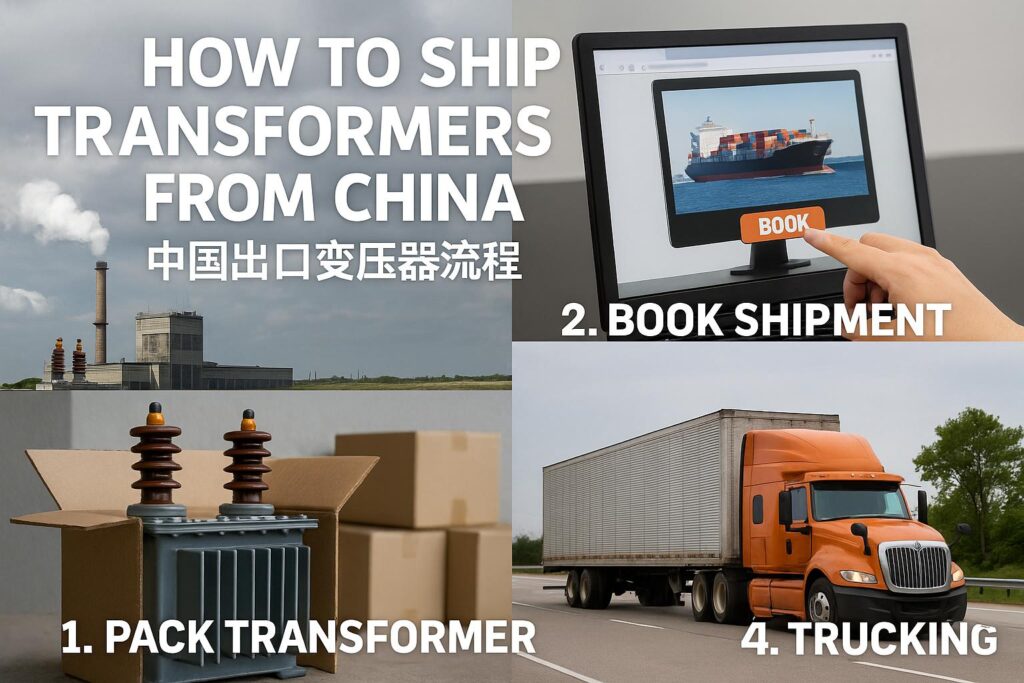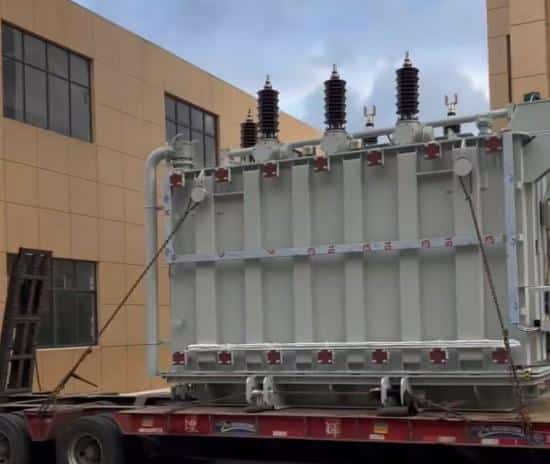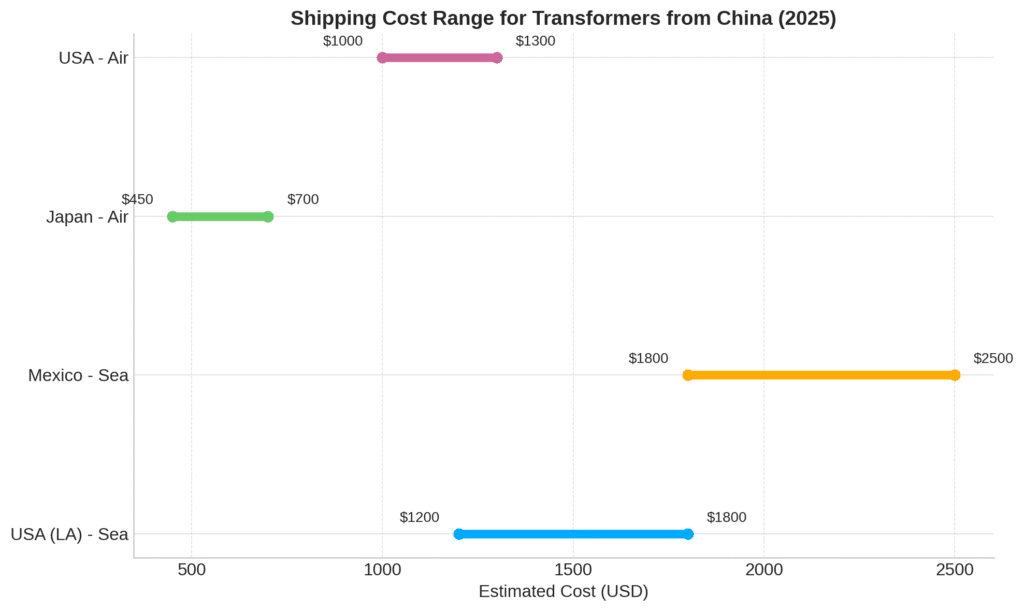Shipping electrical transformers from China has become an essential part of global supply chains, especially as demand for energy infrastructure, industrial automation, and smart grid equipment continues to rise. Whether you’re sourcing large power transformers or smaller distribution units, understanding the best shipping methods, cost breakdowns, packaging requirements, and customs procedures is crucial to ensuring your cargo arrives safely and efficiently. A lot of factors, such as customs checks and port congestion, can accumulate and cause longer shipping times.
In this complete 2025 guide, we explain how to ship transformers from China step by step. From choosing the right freight method—sea freight, air freight, or door-to-door service—to preparing the correct import documents and navigating customs clearance, we help you avoid costly mistakes and shipping delays. Even a small bit of delay can impact the overall delivery time, especially during peak periods.
Whether you’re importing for utility infrastructure in the USA, renewable energy projects in Mexico, or industrial machinery supply in Japan, this guide is tailored for importers who need reliable, professional logistics for transformers sourced from China. Shipping can sometimes take several weeks or even a month, depending on the method and current global conditions.

Introduction to Shipping Transformers from China
Shipping electrical transformers from China is a process that requires careful coordination and attention to detail. As one of the world’s leading exporters, China accounts for over a third of global electrical transformer exports, making it a key player in the international market. When you decide to ship transformers from China, it’s important to choose a reputable store or seller with proven experience in handling these heavy and often complex packages. The process typically starts with the seller providing a tracking number, allowing you to monitor your package as it makes its way from China to your destination country. However, it’s not uncommon for tracking updates to be delayed for several weeks, especially during busy shipping periods. This is a normal part of the experience, and being patient can help you manage expectations as your shipment moves through various stages on its journey.
Top Suppliers for Transformers in China
When sourcing transformers from China, it’s essential to work with a verified seller or manufacturer. Most buyers use platforms like Alibaba, Made-in-China, or even Amazon for initial research. However, for large or customized electrical transformers, it’s better to work directly with a certified Chinese supplier. Alternatively, buying domestically-produced or remanufactured transformers can help avoid high import tariffs and reduce supply chain uncertainties, offering increased availability and stability in a fluctuating tariff environment.
- Always verify certifications and compliance with international standards.
- Request detailed product specifications and quality assurance documentation.
- Understand the buying process, including potential challenges such as tariffs, shipping delays, and supply chain issues, to make informed purchasing decisions.
Popular manufacturing hubs include Shenzhen, Guangzhou, and Shanghai. If the required transformer is not in stock, some suppliers may offer alternative solutions or custom builds to efficiently meet your needs.
Tips to Find a Reliable Seller:
- Check feedback and reviews from past international buyers, and look for sellers with a good track record for reliable shipping and customer service
- Compare specs and certifications (CE, UL, ISO9001)
- Ensure the supplier can package and ship transformers properly
- Request their company registration and export license
Popular transformer manufacturing hubs in China include:
- Shenzhen – known for electronics and small-size power supplies
- Shanghai – industrial transformers and export expertise
- Zhejiang / Jiangsu – high-volume production and low cost
Understanding Regulations in China
Navigating the regulations in China is a critical step when shipping electrical transformers. The Chinese government enforces strict customs rules, and any misstep can lead to costly delays or even the seizure of your imported goods. Taxes on imported electrical transformers can significantly increase the total cost, so it’s essential to factor these into your shipping plans. Additionally, China has specific technical specs and standards that all electrical transformers must meet before they can be exported. Working with a knowledgeable seller or store that understands these requirements is key to ensuring your shipment is compliant. In January, China introduced new customs regulations that directly impact the shipping of electrical transformers, making it even more important to stay updated and plan ahead. By understanding these rules and working with experienced partners, you can avoid unexpected costs and ensure your shipment moves smoothly through customs.

Transformer Import Process: Step-by-Step
Once a transformer is ordered from China, the seller will send the shipment to the specified place or destination.
If you’re planning to import transformers from China, follow this structured process to avoid delays and ensure compliance.
- Research suppliers and request quotes.
- Place your order and confirm all details with the supplier. After the order is placed and confirmed, the seller will send the transformer to the agreed-upon place, such as a port or warehouse.
- Arrange shipping and customs documentation.
- Track your shipment and prepare for customs clearance.
- Receive your goods and inspect them upon arrival.
Confirm Transformer Specifications
Discuss technical specs such as:
- Rated voltage and current
- Oil-cooled or dry-type
- Power capacity (in kVA or MVA)
- Weight and dimensions
Additionally, consider the option to build custom transformers tailored to your unique project requirements, which can help address supply chain or tariff challenges.
Choose Shipping Method and Destination
Select the destination country and port:
Choose between FCL, flat rack, or air freight depending on the transformer size.
Get Pro Forma Invoice and Documents
You’ll need:
- Commercial invoice
- Packing list (with package dimensions)
- HS Code (e.g., 8504.34)
- Technical datasheets
Book Freight and Get Tracking Number
Once you book, the freight forwarder will provide a tracking number. You can monitor the shipment from the Chinese warehouse to the port or airport.
Customs Clearance and Arrival
At destination, your customs broker will:
- File import declaration
- Pay customs duties and VAT/tax
- Arrange delivery to your store or building site
In some cases, remanufactured transformers can be shipped in a matter of days or weeks, depending on availability.
Transformer Shipping Cost to Top Destinations
Here’s a sample cost table for shipping small and large electrical transformers from China to common destinations:
| Destination | Method | Weight/Size | Estimated Cost (USD) | Transit Time |
|---|---|---|---|---|
| USA (LA) | Sea (FCL) | 5 tons / 18 CBM | $1,200 – $1,800 | 18–25 days |
| Mexico | Sea (FCL) | 3 tons / 12 CBM | $1,800 – $2,500 | 22–30 days |
| Japan | Air Freight | 150 kg / 1.2 CBM | $450 – $700 | 3–5 days |
| USA | Air Freight | 300 kg / 2.3 CBM | $1,000 – $1,300 | 5–7 days |
Tariffs on imports can raise the price of shipping transformers, making it more expensive for buyers. These increased costs hit the industry hard, especially when sourcing uncommon or custom units, as tariffs and customization options can further drive up expenses.
Prices vary by season, fuel surcharges, and port availability. Contact us for updated rates.

How to Prepare the Right Documents
To ensure smooth customs clearance and avoid delays, include the following paperwork with your shipment:
- Commercial Invoice – showing the product description, quantity, unit price, and total cost
- Packing List – detailed listing of packages, including number of boxes and weight
- Technical Specification Sheet – for customs to classify the item
- Bill of Lading – proof of shipment by sea
- Certificate of Origin – may be required for preferential tariffs
Don’t forget to double-check the HS code. Most power transformers use 8504.33 or 8504.34, depending on rated power.
Common Issues and How to Avoid Them
When shipping bulky transformers internationally, you may face some common problems. It can be hard to predict shipping costs and timelines due to changing tariffs and volatile market conditions:
| Issue | Solution |
|---|---|
| Delayed shipment | Ask for early booking; avoid peak season |
| Incorrect specs | Double-check power ratings and voltage requirements |
| Damaged package | Use reinforced crates and vibration protection |
| Missing documents | Verify export documents before departure |
| Long customs clearance | Hire a broker familiar with imported electrical equipment |
| High tax or duties | Check local import tax rules and prepare accordingly |
There are practical ways to prepare for these things, such as planning ahead, working with experienced brokers, and staying updated on changing tariff regulations.
Pro tip: Always request loading photos and packaging verification before shipment.
Frequently Asked Questions (FAQs)
How long does it take to ship transformers from China?
Shipping time depends on the method and destination:
- Sea freight to the USA: ~20–30 days
- Air freight to Japan or Europe: 3–7 days
- Door-to-door: 12–25 days (including customs clearance)
What is the best way to ship electrical transformers internationally?
Sea freight is best for large or heavy transformers. Air freight works for smaller, urgent shipments. Use flat rack containers for oversized units.
Do I need to pay customs duties when importing transformers?
Yes, most countries charge import taxes based on the HS Code, product value, and country of origin. A customs broker can help calculate costs.
Can I track my transformer shipment from China?
Absolutely. Once the freight is booked, you will receive a tracking number from the shipping company or your freight forwarder.
What packaging is recommended for transformers?
Transformers should be vacuum-sealed, crated with wood or steel, and cushioned with foam for vibration protection. Markings like “High Voltage” and center of gravity are also required.
Conclusion: Get Expert Help for Transformer Shipping from China
Shipping transformers from China can be complex due to their technical specifications, weight, and regulatory requirements. But with proper planning and a reliable freight forwarder, the process becomes much smoother.
At Tonlexing, we specialize in handling electrical transformer shipments, offering solutions like sea freight, air freight, flat rack transport, and customs clearance support for industrial and commercial clients worldwide.
Contact us today to get a competitive quote for your next transformer shipment.


